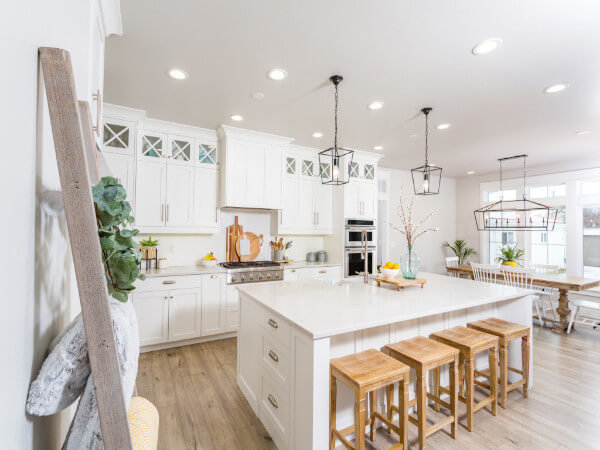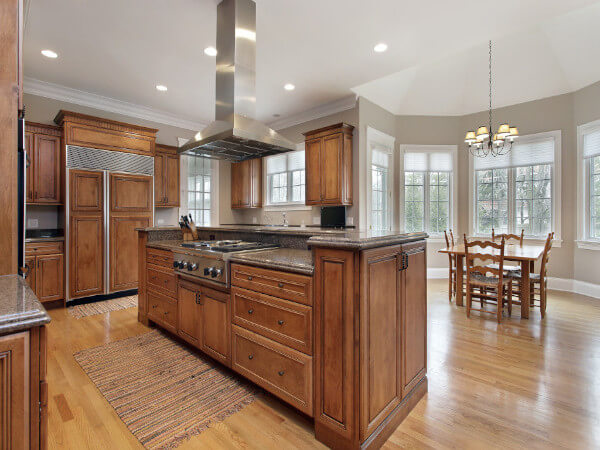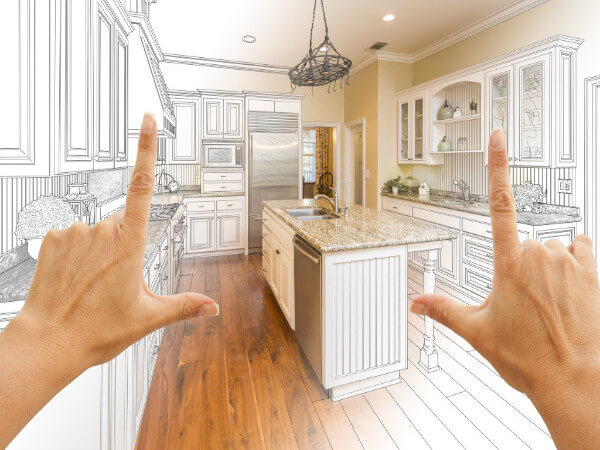Battling the Supply Chain Woes
Qianyan Cheng has felt the sting of the industry’s historic supply chain disruptions.
The co-founder of INOX – the Sacramento-based supplier of decorative hardware and door locks – Cheng has reported lengthy shipment delays of international goods since the onset of COVID-19. Shipping costs, Cheng tells Kitchen & Bath Design News, have risen exponentially in the face of the public-health crisis. The growing backlog of cargo ships waiting to offload in key ports, she says, has increased more than fourfold in some cases, impacting distribution throughout the company’s worldwide network of upscale hardware showrooms. Related bottlenecks have delayed remodeling and new-construction projects for months – or postponed them entirely.
And Cheng, of course, is far from alone.
Indeed, supply chain disruptions wrought largely by the coronavirus continue to prove a major impediment across virtually all segments of the kitchen and bath industry, including dealers, design firms, manufacturers, importers and building/remodeling construction firms.
In some instances, the supply chain timeline has doubled or tripled due to increased demand coupled with port closures, worker shortages and travel restrictions, as well as vaccine and testing mandates for seafarers, truck drivers and other transport workers. Design firms are witnessing increasing lead times, raw material scarcities and double-digit price hikes for certain products. Labor rates have skyrocketed in the face of worker shortages. Cancellations and postponements have increased, with clients opting to put projects on hold until wait times and costs normalize. At the same time, a sizable number of manufacturers report ongoing capacity restraints, a scarcity of raw materials and the discontinuation of slow-moving product lines to alleviate production constraints.
Equally vexing is the likelihood that the current disruptions will linger well into 2022, and perhaps beyond, despite growing appeals for corrective action.
To wit, the Association of Home Appliance Manufacturers, the organization representing many of the industry’s leading appliance suppliers, last month lent its support to a coalition of trade associations urging government policymakers to address ongoing challenges that business leaders say are damaging the competitiveness of manufacturers, stalling America’s economic recovery and resulting in unprecedented damage to the global product supply chain. AHAM’s call for action, following a similar appeal by the National Association of Home Builders, came one day after a coalition of workers from across the supply chain warned that global trade is facing a potential system collapse if world leaders fail to restore freedom of movement to transport workers.
While some supply chain challenges – such as import tariffs – require long-term, systemic solutions, others can be mitigated by kitchen and bath dealers, designers and remodelers who are willing to temporarily alter their business approach.
For example, many design firms report that they’ve become adaptive to current supply chain challenges, ordering products months in advance to circumvent long lead times and lessen the sting of price hikes. Others say they’ve ordered materials as soon as project contracts are signed, even if a job is weeks out, or have stocked up on commonly used products in an effort to reduce delays. Still others are offering clients alternative products that are easier to obtain or already in stock. Frequent and candid communication regarding extended lead times, back orders and volatility in delivery dates has also become more critical than ever in managing client expectations and preserving relationships, dealers and designers say.
The kitchen and bath design trade has faced a multitude of challenges over the course of its existence. The advent of big box stores and e-commerce has altered the industry’s competitive set. Corporate bankruptcies, ownership changes, factory closures and divestitures have reshaped the manufacturing and retail landscape. Fast-changing lifestyles, homeowner demographics, product introductions and consumer hot buttons have exacerbated the need to stay abreast of what’s going on. Economic downturns have occasionally knocked the industry on its heels.
Astute dealers and designers, for decades, have proven resilient to these and other changes. They’ll doubtless discover ways to survive the current supply chain disruptions, as well. 
The post Battling the Supply Chain Woes appeared first on Kitchen & Bath Design News.
Did you miss our previous article…
https://www.texaspiekitchen.org/?p=793
Examining the Origins of Creativity
Have you ever been asked, “Where did you get that idea?”
Have you ever wondered what creativity is, and where ideas come from? I have – all my adult life. While there are many answers, I think a great one is, “It’s a gift to be shared.”
What I’m talking about specifically here are unique solutions that solve problems, like storage needs and designing for function and safety. Combine these challenges with the homeowner’s desire for a unique appearance that fits their lifestyle, and the result? We have the makings of an award-winning kitchen or bathroom.
Design award applications usually require a summary of how we solved the project owner’s problems, and the recap makes before-and-after photos more relevant. If our entries offer original solutions, they deserve praise. The recognition boosts our confidence.
THE ORIGINS
Where does creativity originate? You’re taking a shower, and an idea flashes out of nowhere. You think to yourself, “What if I…?” You can’t wait to test the reality of your idea on your clients’ plans. From that idea comes another one, and another one. It’s like someone unlocked the vault of ingenious results for you. You’re motivated.
Albert Einstein said, “Creativity is intelligence having fun.” He had intimate knowledge of the universe, and he understood visionary imagination.
As kitchen-bath design specialists, we have a collection of skills and information acquired through our experience. Our intelligence allows us to apply the knowledge to solve problems. But, it’s more than that. Creativity frees our minds to absorb knowledge. It enables alternative ways of thinking.
How do you feel when you discover a spectacular new product at the Kitchen & Bath Industry Show, or in a Kitchen & Bath Design News article? There’s a tingle of excitement, and you can’t wait to solve homeowners’ problems with it. Creativity unblocks our old patterns of thinking. As a result, we’re more receptive to new ideas.
I’ve experienced good luck with product information that got tucked in the “future use file” of my mind. For example, I recommended a Duravit all-glass pedestal lavatory to a new client six months after I learned about it. She still loves it!
And I remember the drop-dead gorgeous Vetrazzo “Sky” countertop that wowed clients when I created a new laundry room for them – two years after discovering Vetrazzo for a blog. Then there was the joy I felt recently, saving a client over $3,000 by substituting bronze plumbing fittings I’d seen in an online newsletter last year.
These experiences are not uncommon for us.
Creativity is fun. We lose track of time when we’re engrossed in creating plans for a client or researching the right products that will make their hearts sing. Getting into a “zone” is like meditating. Experts agree that this helps us live longer. Somehow, we find a way to balance our desire to innovate and perform boring – but necessary – tasks.
Creative ideas are everywhere, always available to us when we need or want to improve our world. One way to explain it is finding a need and then creating a solution. Creativity helps draw out what is already there waiting to be used so that possibilities can emerge. Albert Einstein understood this concept and taught it passionately.
Early in my career, I had a client who wanted to store two sets of eating utensils in her small condominium kitchen with space for only five drawers. I designed a drawer within a drawer, instructing the cabinetmaker to lower the drawer back and then install full-extension glides backward on the top section so it slid back. About six months later, Rev-A-Shelf introduced the same solution for the mass market. So, I was solving an individual need at the same time that Rev-a-Shelf was solving a popular need.
BUILDING CONNECTIONS
Creativity builds intercultural and intergenerational connections.
This is shown by the worldwide acclaim of America’s architectural genius, Frank Lloyd Wright. He died in 1959, at 91. Yet his work still inspires architects and designers 62 years later. Wright was the first architect in history to use cantilevering in his famous Mill Run, Pennsylvania home. He designed “Fallingwater” for Edgar Kaufman in 1935. Evidence of his continuing popularity? Architects and designers are recreating Wright’s “Prairie-style” homes for today’s homeowners.
I love one of the stories about Wright – and there are thousands! He had very little income from his architecture practice for about 12 years (1922–1934). But he kept drawing plans and renderings for residences and public buildings. He also created graphic art for postcards. And he was a prolific writer. Hundreds of his articles appeared in House Beautiful and other popular magazines during that period. His self-promotion paid off. Clients began hiring him in 1934 after they recovered from the depression. He never looked back, proving that creativity is nurturing. Wright had more successful commissions in the last 30 years of his life than he had in the first 61 years!
Like Wright and other well-known innovators, today’s designers will impact future designers. They will inspire and motivate everyone to achieve their own success. We see this in our profession now. Many peers earn honors for their work because they are fearless in their creative expression. Their work will pass the test of time. They are not bound to what’s popular now because they are thinking ahead to the future. They have curiosity and open minds to play the “What if?” game. They often win.
But we see only the wins, not the losses. Creative people have a great habit of learning from every experience. They’re driven to improve themselves and everything around them.
I became aware of this when I taught Western design to Japanese interior design students in San Francisco and gave them a special assignment. They had to create a large master bathroom in a 17’x17′ area. Naturally, they were eager to learn and use the new skills they’d acquired. Not accustomed to large bathrooms, the students had fun uncorking their creativity.
There was one student, Izumi, who lit up the room with her enthusiastic ideas and questions. When it was time to review her plan one-on-one, she was trembling, afraid that I would criticize her work. Her plan wasn’t to scale. But her design was unique and it earned my praise for achieving something radically different. She designed a round bathroom with many windows surrounding a center closet! We joyfully worked together after class, figuring how to make her idea possible.
Like Izumi’s bathroom, I’ve come full circle – back to where I started, with the same question: What is creativity, and where does it come from? The conclusion: Creativity, like love, is an unlimited feeling, indefinable.
No, creativity is love. 
Diane Plesset, CMKBD, CAPS, NCIDQ is the principal of D.P. Design in Oregon City, OR and has over 35 years of experience as a kitchen and bath designer. She is the author of the award-winning book, THE Survival Guide: Home Remodeling, and has been the recipient of numerous design awards. Named a 2019 KBDN Innovator, Plesset has taught Western design to students of the Machida Academy in Japan and has a podcast, “Today’s Home.”
The post Examining the Origins of Creativity appeared first on Kitchen & Bath Design News.
Did you miss our previous article…
https://www.texaspiekitchen.org/?p=790
Sustainability Has Cross-Market Impact
INDIANAPOLIS, IN — A trio of emerging trends in neighborhood design and sustainable living practices should continue to shape the market for new housing and residential remodeling as the “mindset of consumers continues to shift in a dynamic social climate,” according to a new report from the Home Improvement Research Institute (HIRI).
According to HIRI’s recently issued Future of Housing Trend Report, new and remodeled homes will likely be shaped by a “growing homeowner passion” regarding issues such as climate change, sustainability and minimalism –
resulting “in an increased emergence of eco-friendly materials and 3D-printed technology to designs focused on cultural inspiration and reversible architecture.”
Among the key trends identified by HIRI researchers are the following:
Sustainable Housing: With sustainability a top priority, residential architects and designers are embracing different eco-friendly concepts, among them “reversible design” (the architecture of structures that can be easily deconstructed and can be reused or with parts that can be removed and added easily). Also growing as a trend in new construction is 3D-printed housing – homes that offer sustainable and protective construction that avoids structural issues in the case of extreme weather, according to HIRI.
“Contemporary consumers are wary of the impending consequences of climate change, and a large number are becoming increasingly aware that simply shifting their lifestyle and practicing ecological mindfulness are likely not enough,” the Indianapolis, IN-based HIRI said. “As a result, many are demanding that brands and creators take the environment into consideration.”
Simplified Living: Building off of the desire for more sustainable living, the emergence of simple, more minimalist design emphasizes homeowners’ functions and needs, according to HIRI.
“Contemporary consumers in fast-paced urban centers are looking to balance the demands of their daily lifestyle with a comfortable home environment,” HIRI observed. “Many are prioritizing minimalist designs and additional spaces that can optimize and elevate their living situation without compromising aesthetic appeal.”
Flight from the cities: “As urban centers expand in size and population, consumers are recognizing that their quality of life is suffering – whether that be due to alienation, affordability issues, lengthy commutes or pollution,” HIRI said. As a result, many are moving away from city centers and turning to community-based neighborhoods that provide a sense of belonging while also satisfying the need for convenience and cleaner air.
“Hyper-local neighborhoods”: Architects, developers and local governments are proposing neighborhoods that are centered on community building and local businesses, according to HIRI. These neighborhoods are intended to be car-free, with all necessities reachable via a short walk or bicycle ride. 
The post Sustainability Has Cross-Market Impact appeared first on Kitchen & Bath Design News.